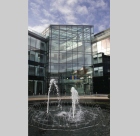ADT provides fire detection for private hospital in Eire

ADT Fire & Security has been specified by Suir Engineering to deliver an intelligent fire-detection and alarm system as part of the £15 million development of the new Mater Private Hospital in Cork, Ireland. This large and complex facility requires a reliable and robust system to reduce the risk of false alarms.
This hospital offers day-case and inpatient services in purpose-built and state-of-the-art facilities.
The ADT system comprises four MZX fire-control panels a TGX graphical user interface, a 64-zone Atheis public-address voice-alarm system, four Vesda aspirating smoke-detection systems and a damper system to help prevent the spread of a fire should one ever occur.
There are over 280 fire dampers, each controlled automatically to stop the spread of smoke gases and fumes.
The TGX graphics enable the dampers to be closely monitored via visual displays throughout the hospital. The seamless integration of the damper and fire-detection system reduces maintenance costs.
The MZX digital addressable fire-alarm system has multi-sensor virtual detection. The cause-and-effect programming with TSM 800 fail-safe door control can isolate any fire by activating fire doors to protect predetermined escape routs to ensure safe evacuation.








